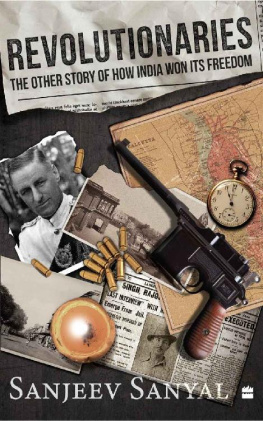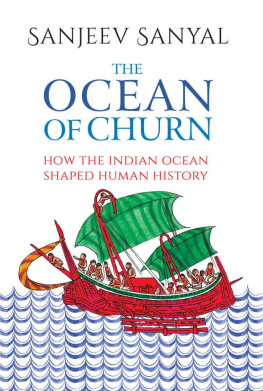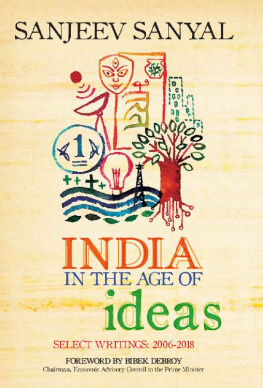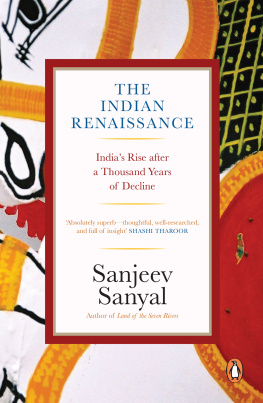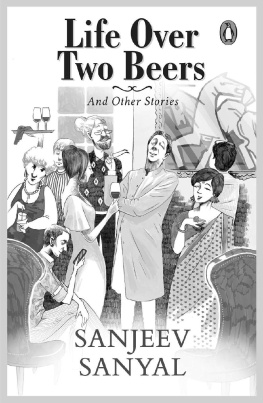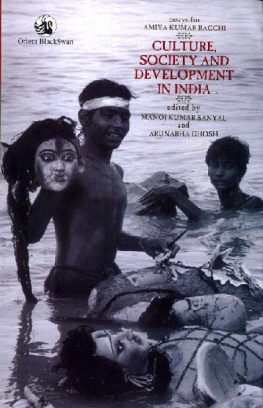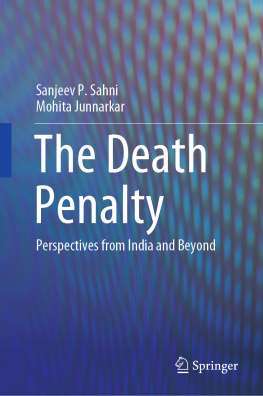Sanjeev Sanyal - Revolutionaries: The Other Story of How India Won Its Freedom
Here you can read online Sanjeev Sanyal - Revolutionaries: The Other Story of How India Won Its Freedom full text of the book (entire story) in english for free. Download pdf and epub, get meaning, cover and reviews about this ebook. year: 2023, publisher: HarperCollins India, genre: Politics. Description of the work, (preface) as well as reviews are available. Best literature library LitArk.com created for fans of good reading and offers a wide selection of genres:
Romance novel
Science fiction
Adventure
Detective
Science
History
Home and family
Prose
Art
Politics
Computer
Non-fiction
Religion
Business
Children
Humor
Choose a favorite category and find really read worthwhile books. Enjoy immersion in the world of imagination, feel the emotions of the characters or learn something new for yourself, make an fascinating discovery.
- Book:Revolutionaries: The Other Story of How India Won Its Freedom
- Author:
- Publisher:HarperCollins India
- Genre:
- Year:2023
- Rating:3 / 5
- Favourites:Add to favourites
- Your mark:
- 60
- 1
- 2
- 3
- 4
- 5
Revolutionaries: The Other Story of How India Won Its Freedom: summary, description and annotation
We offer to read an annotation, description, summary or preface (depends on what the author of the book "Revolutionaries: The Other Story of How India Won Its Freedom" wrote himself). If you haven't found the necessary information about the book — write in the comments, we will try to find it.
Revolutionaries: The Other Story of How India Won Its Freedom — read online for free the complete book (whole text) full work
Below is the text of the book, divided by pages. System saving the place of the last page read, allows you to conveniently read the book "Revolutionaries: The Other Story of How India Won Its Freedom" online for free, without having to search again every time where you left off. Put a bookmark, and you can go to the page where you finished reading at any time.
Font size:
Interval:
Bookmark:

When millions upon millions of voices roar out your name,
And millions upon millions of swords rise up to defend you,
Who says, Mother, that you are weak?
Extract from Bankim Chandra Chatterjees Vande Mataram,
as translated by the author
CONTENTS
T HIS BOOK DISCUSSES MANY EVENTS AND CHARACTERS THAT I had wondered about since childhood. Somehow, the official narrative of Indias freedom struggle never quite seemed to add up. Subhas Bose was much venerated in Kolkata, where I grew up in the 1980s, but there was always some unsaid hesitancy about discussing the events related to his life. I would often stumble upon pieces of history that looked like they were important but were never spoken about. For instance, I first learnt about the Naval Revolt of 1946 in my twenties, when I chanced upon a small memorial in Colaba, Mumbai. It seemed like a major incident, but I had never read about it in history class or seen it discussed in television documentaries. Almost no one in the city seemed to know much about it. Similarly, it came as a complete surprise to me to learn that the much-revered spiritual guru Sri Aurobindo was one of the founding fathers of the revolutionary movement.
In the course of researching my earlier books, I had picked up titbits of information about the revolutionaries that I had then kept aside. Enough pieces accumulated over time for a new picture of the freedom struggle to emerge. So many books have been written about the period and about individual freedom fighters that I had assumed that the history of the freedom struggle was a settled matter. However, another narrative seemed to suggest itself at every turn. At some point, perhaps in 2014, I decided that it was worth researching the matter more systematically. For the next few years, I collected books written by those who had participated in the revolutionary movement or witnessed it first-hand. I visited sites related to them across India and the world. Eventually it became an obsessionI had to
write the book.
As readers will guess, some of the characters in this book are related to me. A handful had survived into the 1980s, and I knew them personally. However, I do not claim any special knowledge merely by virtue of this. The history of the revolutionaries only began to take shape in my head after I started to systematically study them. Even the significance of first-hand anecdotes that I had heard long ago fell into place only after I started to research this book. I began to look up old letters and dusty books scattered across the family. Some of my friends began to tell me that their family members, too, had been part of the movement. They, too, shared snippets of information or put me in touch with yet other people. In this way, I was able to steadily add colour to the story. And what a story it isof unbelievable courage and ingenious plots, but also of treachery and heart-breaking failure. Moreover, it is bound up with the major global events of the twentieth century, including the World Wars, the Russian Revolution and Irish Independence.
A book such as this is a team effort. I remember walking around London with Vikas Nanda in unusually heavy rain, looking for places related to Udham Singh, Madanlal Dhingra and Vinayak Savarkar, and then singing the full version of Vande Mataram in their honour at each location. The many long discussions with Jayanta Sengupta and the research team for the Biplobi Bharat Museum (Kolkata)Arka, Poulomi, Meenal and Aryama. The research for this book discovered by chance a long-forgotten box of guns used by revolutionaries, including a Mauser C96 pistol, in the archives of the Nehru Memorial Museum and Library, Delhi. These are now displayed at the Biplobi Bharat Museum in Victoria Memorial, Kolkata.
Then there was the wonderful day I spent searching for Anushilan Samiti-related sites in north Kolkata with Yash Nathany and Iftekar Ahsan. I am grateful to my old partner-in-crime Odakkal Johnson who took me to see places related to the Naval Revolt in Mumbai; Partha Das who arranged for a tour of the Alipore Central Jail; Priya Kale who took me around Vadodara; Ashok Pal who accompanied me to see the homes of revolutionaries in Nadia; Asni Kumar, who showed me the various INA-related sites in Manipur; and Sameer Gautam, who took me to see Hedgewars house in Nagpur. I would also like to thank Chandralekha Mukherjee and Shivendra Shukla, who arranged for a very emotional trip to Kakori stationthat, too, on a guard van. Then there is the staff at the Delhi Gymkhana library, who dug out a treasure trove of out-of-print books. A special thanks to my friend Rudra Chatterjee for introducing me to the writings of his granduncle, Jogesh Chatterjee; Ranjit Savarkar and Savitri Sawhney for arranging photographs of their forebears; and Rashida Iqbal for old photographs of the Cellular Jail.
In addition, I would like to thank the entire Sanyal clan for all its active supportmy parents, who refreshed my memory on family anecdotes; my cousin Saurabh, who dug up old letters and photographs; another cousin, Rishi, who discovered an interesting tape recording; and, of course, my wife Smita, who accompanied me to sites from Port Blair to Vadodara.
Finally, let me thank my editors at HarperCollins Publishers Indiathe ever-enthusiastic Udayan Mitra and Swati Chopra; the copy-editor Ujjaini Dasgupta and the designer Saurav Das. As I said, publishing a book is a team sport.
T HE DAY OF 26 AUGUST 1914 BEGAN AS JUST ANOTHER SULTRY monsoon morning in Calcutta (now Kolkata), the second most important city of the British Empire. The plan of shifting the capital of British India to Delhi had been announced three years earlier, but for all practical purposes, Calcutta still functioned as the capital. The citys inhabitants would have known about the gathering war in Europe. This had stoked the ambitions of a network of young revolutionaries, who saw it as an opportunity to throw off the colonial yoke through armed insurrection. However, they were also aware that their supply of guns was hopelessly inadequate.
A few days earlier, a group of revolutionaries had received information that a large consignment of arms was to be delivered to RB Rodda & Company, a well-known British-owned arms retailer with outlets in Birmingham, London, Calcutta and other large cities. The source of the information was Srish Mitra, a mole who worked in the company and was in charge of clearing consignments through customs.
The young men met late in the evening on 24 August in a small park off Chatawala Gali. Srish told the others that the consignment included fifty Mauser C96 semi-automatic pistols and 46,000 cartridges. These German-made pistols were considered the best and most reliable in their category. It also had a distinctive wooden stock that was detachable and also functioned as its holster. The order had been shipped out just before the war began.
The group discussed various ideas about how to steal the guns, but not everyone agreed that it was a practical idea. Narendra Bhattacharya (later famous as M.N. Roy) left the meeting after warning the others that it was doomed to fail. The ringleaders, Haridas Dutta, Srish Pal, Khagen Das and Anukul Mukherjee, then retired to Srishs house to work out the details. The following day they reached out to some Marwari friends who lived in a working mens hostel, including Prabhu Dayal Himmatsinka and Hanuman Prasad Poddar. The plan was as ingenious as it was simple.
Around 11 a.m. on 26 August, Srish left his office at Rodda & Co. and headed for Customs House with the money and documents needed for the receipt of the arms consignment. After being cleared through customs, the consignment was to be loaded onto six bullock carts, which would carry the goods to the company warehouse. However, the revolutionaries had arranged for a seventh bullock cart, driven by Haridas Dutta disguised as a Hindi-speaking driver. Their friend, Himmatsinka, had helped dress him up in a shabby dhoti and a genji vest, even a brass locket around the neck. He had also cropped his hair short. Srish then ordered the loading of the crates. Most of the consignment was loaded on the six official bullock carts, but the Mausers and their ammunition were loaded on the seventh.
Next pageFont size:
Interval:
Bookmark:
Similar books «Revolutionaries: The Other Story of How India Won Its Freedom»
Look at similar books to Revolutionaries: The Other Story of How India Won Its Freedom. We have selected literature similar in name and meaning in the hope of providing readers with more options to find new, interesting, not yet read works.
Discussion, reviews of the book Revolutionaries: The Other Story of How India Won Its Freedom and just readers' own opinions. Leave your comments, write what you think about the work, its meaning or the main characters. Specify what exactly you liked and what you didn't like, and why you think so.

